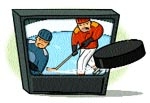HDTV Year in Review Page 3
August
Affordable HDTVs Arrive With its 47-inch (diagonal) screen, built-in line doubler, and 1080i-format display of HDTV programs, Panasonic's widescreen PT-47WX49 high-def monitor was a formidable addition to the company's rear-projection TV (RPTV) line when it rolled into stores last summer. But even more important, its $2,000 price tag marked a narrowing of the gap between the cost of digital sets and their analog counterparts.
Other manufacturers have followed Panasonic's lead in delivering lower-cost options for HDTV. Hitachi and Toshiba now offer widescreen RPTVs with 43-inch screens for under $2,000, while Mitsubishi's 46-incher clocks in at $2,500. There are bargains to be had in the direct-view, 4:3 aspect ratio category as well, with a number of 32- and 36-inch sets selling for between $1,500 and $2,000. These prices are still beyond the reach of many viewers, but they're a lot lower than the prices for first-generation HDTVs, some of which cost upwards of ten grand.
September
 ABC Goes High-Def in Prime Time ABC may have dropped the ball on sports, but the network's decision to offer virtually its entire slate of prime-time shows in high-definition along with a Dolby Digital 5.1 soundtrack was a major boon for HDTV set owners. Joining NYPD Blue, which the network started broadcasting in high-def in late 2000, are such popular fare as Alias, The Drew Carey Show, Dharma and Greg, and Spin City. The network also decided to continue its weekend high-def movie broadcasts, delivering such well-known titles as Saving Private Ryan, Mission: Impossible, and Good Will Hunting.
ABC Goes High-Def in Prime Time ABC may have dropped the ball on sports, but the network's decision to offer virtually its entire slate of prime-time shows in high-definition along with a Dolby Digital 5.1 soundtrack was a major boon for HDTV set owners. Joining NYPD Blue, which the network started broadcasting in high-def in late 2000, are such popular fare as Alias, The Drew Carey Show, Dharma and Greg, and Spin City. The network also decided to continue its weekend high-def movie broadcasts, delivering such well-known titles as Saving Private Ryan, Mission: Impossible, and Good Will Hunting.
Elsewhere on the dial, it was a mixed bag. NBC continued with The Tonight Show and added Crossing Jordan to its high-def slate. PBS, meanwhile, aired a diverse selection of HDTV programs. Recent highlights include Nova: Life's Greatest Miracle, National Geographic Special: the Quest for Noah's Flood, and the documentary River of Iron: Dreams of a Grand Canyon Railroad. PBS's digital stations also broadcast a number of programs in widescreen 16:9 format, but with standard-definition resolution (comparable to NTSC). Some also experimented with multicasting, which could provide significant new sources of revenue for the public-supported stations. The standard-definition 480p (progressive-scan) format was the norm for the remaining digital broadcasters, which include Fox and WB network affiliates. Curiously, a few Fox shows have aired in a widescreen format, and WPIX-DT, the WB affiliate in New York, showed a handful of Mets baseball games in high-definition during the 2001 season. The National Association of Broadcasters predicts that 90% of the country will be in range of off-air digital broadcasts by April. This increased coverage, plus lower HDTV prices, will expose more viewers to the high-resolution images and Dolby Digital surround sound that set HDTV apart from standard TV - which should increase demand for high-def programming.
- Log in or register to post comments






























































